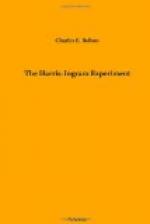No doubt, love of discovery and of trade also stimulated the Dutch in making explorations. In the vessel “Half Moon” they sailed up the Hudson, and after building several forts, they finally established themselves in New Netherlands. Peter Minuit for a trifle bought from the Indians the whole of Manhattan Island. In locating on Manhattan Island, the Dutch secretly believed that they had secured the oyster while the English settlements further north and south were the two shells only. The development of almost three centuries and the supremacy of New York to-day, as the new world metropolis, verifies the sound sense of the Dutch.
Christine was alive to the important part which her countrymen had early played across the Atlantic. Her mother had died, and Christine still unmarried, controlled both her time and a goodly inheritance. She resolved to visit her sister Fredrika, whose husband was agent in New York of a famous German line of vessels.
En route from Holland to New York she spent two weeks with friends in London, and on Regent Street replenished her wardrobe, enjoyed Irving and Terry in their latest play, attended an exciting Cambridge-Oxford boat-race on the Thames, and with a great crowd went wild with delight at the English races at Epsom Downs.
Saturday at 9:40 A.M. at the Waterloo Station several friends saw Christine off for America on the special train, the Eagle Express, of the South Western Railway, which makes the journey of 79 miles to Southampton in one hour and forty minutes.
At Southampton the passengers were transferred on the new express dock, direct from the train to the steamers, which are berthed alongside. By this route passengers escape exposure to weather on tenders and landing stage, and avoid all delays at ports of call, and waiting for the tides to cross the bar.
Promptly at 12 o’clock, hawsers and gangways vanishing, the great steamer moved down the bay, the fertile Isle of Wight in sight. Officers made note of the time as the Needles were passed, as the runs of the steamers are taken between the Needles and Sandy Hook. It was a bright breezy afternoon and after lunch the passengers lounged on the decks, or in the smoke room; some inspected their rooms, some read the latest French or English novel, and others in groups gossiped, or walked the decks to sharpen appetite.
The second steward, of necessity a born diplomat, had succeeded in convincing most who were at lunch that he had given them favored seats, if not all at the Captain’s table, then at the table of the first officer, a handsome man, or at the table with the witty doctor.
Christine did not appear at lunch, as she was busy in her stateroom. She had given careful instructions that one of her trunks should be sent at once to her room. An hour before dinner there appeared on the promenade deck a beautiful young woman dressed in black, who attracted attention and no little comment. She wore a dress of Henrietta cloth, and cape trimmed with black crepe and grosgrained ribbons in bows with long ends. Her tiny hat with narrow band of white crepe was of the Marie Stuart style; her gloves were undressed kid, her handkerchief had black border, and her silk parasol was draped in black.




